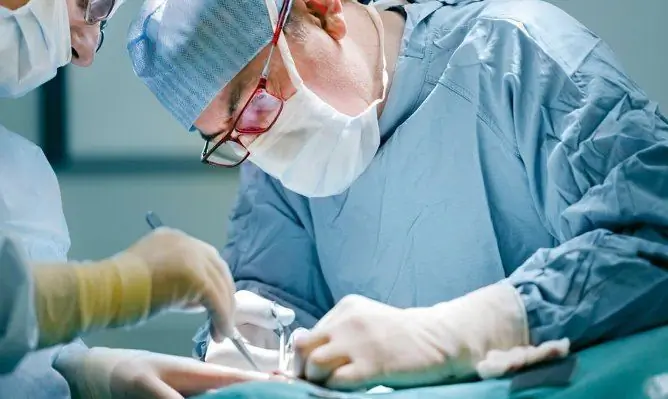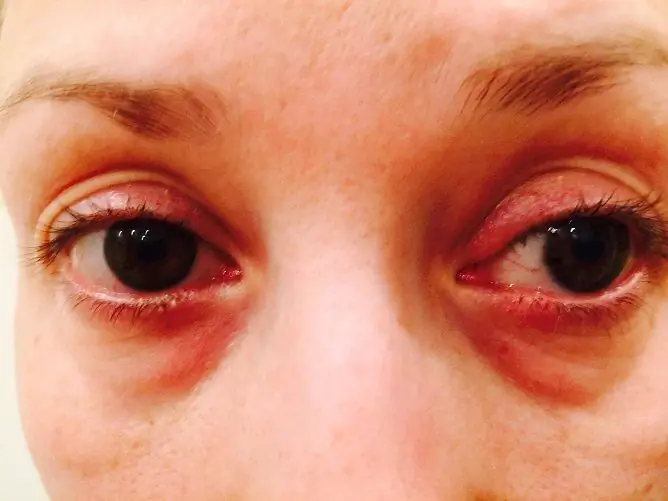- Author Rachel Wainwright [email protected].
- Public 2023-12-15 07:39.
- Last modified 2025-11-02 20:14.
Inguinal hernia in children
The content of the article:
- Causes and risk factors
- Forms of the disease
- Symptoms of an inguinal hernia in children
- Diagnostics
- Inguinal hernia treatment in children
- Potential consequences and complications
- Forecast
- Prevention
An inguinal hernia in children is a protrusion through the inguinal canal of the vaginal process of the peritoneum, which forms a hernial sac, which includes some internal organs (hernial contents). In children, inguinal hernias are usually congenital. Acquired are extremely rare - they develop in school-age boys who have a weak abdominal wall or are involved in weightlifting.

Inguinal hernias in children are most often congenital
Inguinal hernia in children is a widespread pathology. They are observed in 5% of full-term and 20-25% of premature babies. Often combined with other pathology:
- dropsy of the testicle (hydrocele);
- spermatic cord cyst;
- Marfan syndrome and other connective tissue diseases;
- anomalies in the development of the spinal column;
- spinal hernia;
- dysplasia of the hip joints.
Inguinal hernias in children are three times more common in boys. Presumably, this is due to the process of migration of the testicle into the scrotum from the abdominal cavity through the inguinal canal.
Causes and risk factors
The main role in the formation of congenital inguinal hernias in children belongs to the blind pocket of the peritoneum (processus vaginalis) protruding through the inguinal canal into the scrotum. After the testicle descends into the scrotum, the processus vaginalis obliterates, that is, overgrows. This usually happens by the time the baby is born. If, for some reason, obliteration does not occur, then the inguinal canal does not close and with an increase in intra-abdominal pressure, internal organs exit through it. The hernial orifice is the outer ring of the inguinal canal, and the vaginal process of the peritoneum is a hernial sac, which can include intestinal loops, omentum, fallopian tube and ovary (in girls).
In the development of inguinal hernia in children, hereditary predisposition is of no small importance. According to statistics, about 12% of children with this pathology have one or both parents also had an inguinal hernia.
Acquired inguinal hernias in children, as mentioned above, are extremely rare. Factors provoking their development:
- obesity;
- drastic weight loss;
- sedentary lifestyle;
- lifting weights;
- respiratory diseases, accompanied by severe cough;
- chronic constipation.

Weight lifting by a child is a predisposing factor for an inguinal hernia
Forms of the disease
Depending on the site of localization, inguinal hernias in children are bilateral, left-sided and right-sided. In girls, in 50% of cases, bilateral hernial protrusions are observed. In boys, bilateral inguinal hernias occur in 10% of cases, in 30% - left-sided, and in other cases - right-sided.
As a rule, in children, inguinal hernias pass through the inner inguinal ring and are located in the inguinal canal, that is, they are oblique. Direct inguinal hernias are extremely rare in pediatric practice. The hernial protrusion in this case passes through the defect in the muscles of the anterior abdominal wall in the area of the external inguinal ring.
In boys, the hernial sac can descend into the scrotum, which leads to the formation of inguinal-scrotal hernias, which, in turn, are divided into testicular (ovarian) and funicular (cord) hernias.
Symptoms of an inguinal hernia in children
The main symptom of an inguinal hernia in children is the presence of a tumor-like protrusion in the groin area. When straining, crying, screaming, coughing a child, it increases in size, at rest decreases, and sometimes completely disappears.
With an inguinal-scrotal hernia in boys, there is a deformation of the scrotum due to the lowering of the hernial sac into it. In girls, the hernial sac can descend into one of the labia, causing it to thicken.
Inguinal hernias in children are often accompanied by pain localized in the lower abdomen or groin area. Pain can be given to the lower back or sacrum. They can cause crying and whims of children in the first year of life. At an older age, babies inform their parents about pain in the lower abdomen.

An inguinal hernia in a child is manifested by a tumor-like protrusion in the groin area
Diagnostics
An inguinal hernia in children is usually detected either by the parents themselves or by a doctor during a routine examination.
Palpation reveals an elastic or soft consistency of protrusion in the groin area. With an uncomplicated course, the hernial contents are easily adjusted into the abdominal cavity. At the time of reduction, you can hear a characteristic rumbling, which indicates that the intestinal loop is in the hernial sac. After the hernial protrusion is set into the abdominal cavity, the expanded external inguinal ring is felt.
In order to clarify the diagnosis, perform:
- ultrasound examination of the abdominal organs, small pelvis, inguinal canals and scrotum;
- irrigography;
- cystography.
Inguinal hernia in children requires differential diagnosis with the following diseases:
- femoral hernia;
- inguinal lymphadenitis;
- cyst of the round ligament of the uterus (in girls);
- cryptorchidism (in boys);
- spermatic cord cyst (in boys);
- dropsy of the testicle (in boys).
Inguinal hernia treatment in children
Currently, conservative treatment of inguinal hernias in children with adhesive bandages and bandages is not performed.
Removal of an inguinal hernia in children with an uncomplicated course is performed routinely at the age of over six months. During the operation, the surgeon separates, ligates and cuts off the hernial sac, and then performs the plastic surgery of the hernial orifice with the patient's own tissues or using a special propylene mesh.
Attention! Photo of shocking content.
Click on the link to view.
Surgery for inguinal hernia in children can be performed using the classical open method, or using laparoscopic technologies. The latter method is more preferable, as it is accompanied by minimal trauma to soft tissues, minor blood loss and a short rehabilitation period.
Removal of an inguinal hernia in boys should be performed with great care to avoid possible injury to the vas deferens and testicular vessels (spermatic cord). Their damage further leads to testicular atrophy and / or male infertility.
The development of an entrapment of an inguinal hernia in girls is an indication for emergency surgery, since there is a very high risk of death of the fallopian tube or ovary. In boys of the first months of life, with the development of infringement in the first few hours, conservative therapy is carried out aimed at self-reduction of the hernia. In this case, the following treatment regimen for inguinal hernia in children is used:
- a warm bath or heating pad;
- intramuscular administration of drugs with an antispasmodic effect;
- giving the child a position with a raised pelvis.
If the treatment does not lead to the disintegration of the inguinal hernia, they resort to emergency surgery. In case of strangulated inguinal hernias in children, the operation has its own characteristics. First of all, the surgeon must assess the viability of the organs included in the hernial sac. Reduction into the abdominal cavity is possible only if the viability of the intestine, omentum, ovary or other elements is beyond doubt. Otherwise, they are resected.
Potential consequences and complications
The main complication of an inguinal hernia in children is its infringement. It develops as a result of compression by the external inguinal ring of the hernial contents (ovary, omentum, bowel loop, bladder wall), which leads to ischemia of the restrained organs.
Constipation, flatulence, severe cough can provoke the development of infringement.
The main symptoms of an entrapment of an inguinal hernia in children are:
- groin pain (small children cry, press their legs to their stomach);
- the hernial protrusion becomes tense and sharply painful on palpation, it is impossible to set it into the abdominal cavity;
- nausea, repeated vomiting;
- bloating;
- delay in passing gas and stool.
With a delay in surgical treatment, the child develops peritonitis.
Ovarian tissue is very sensitive to ischemia, therefore, even a short-term infringement can cause ovarian necrosis, death of eggs.
Infringement is dangerous for the male reproductive system. So, in 5% of boys, after suffering an infringement of an inguinal hernia, testicular atrophy develops in the future.
Forecast
Removal of uncomplicated inguinal hernias in children is currently performed in most cases in a day hospital. The child is discharged for outpatient treatment on the day of surgery or the next morning.
Recurrence of inguinal hernias in children is observed in 1% of cases (most often after emergency interventions or in premature babies).
Complications of hernia repair are extremely rare. These include:
- infertility;
- high testicular fixation;
- lymphocele;
- testicular lymphostasis.
Prevention
Prevention of inguinal hernia formation in children includes:
- balanced diet;
- control of body weight;
- constipation treatment;
- treatment of respiratory diseases accompanied by cough;
- physical activity appropriate for age and muscle strength.
YouTube video related to the article:

Elena Minkina Doctor anesthesiologist-resuscitator About the author
Education: graduated from the Tashkent State Medical Institute, specializing in general medicine in 1991. Repeatedly passed refresher courses.
Work experience: anesthesiologist-resuscitator of the city maternity complex, resuscitator of the hemodialysis department.
The information is generalized and provided for informational purposes only. At the first sign of illness, see your doctor. Self-medication is hazardous to health!






